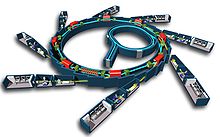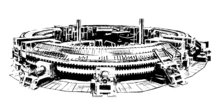同步加速器

同步加速器(英語:Synchrotron)是一種環形的粒子加速器,使用磁場(讓帶電粒子在運行中可以改變方向)及電場(加速帶電粒子)與運行中的帶電粒子束同步化操作。它最初是由阿爾瓦雷茨发明的用于研究高能粒子的裝置。 粒子迴旋加速器使用均勻的磁場及固定頻率變化的電場加速帶電粒子,如果改變其中一項則為同步粒子迴旋加速器,兩者都改變則為同步加速器。粒子在粒子迴旋加速器中,從中心以螺旋軌道運行到腔壁時,粒子迴旋加速器的最大半徑限制了粒子最後所獲得的全部能量。另一方面若以增加磁場強度的方式來提高加速能量,也有其極限。所以有同步加速器的出現。同步加速器中的粒子束具有固定軌道,藉著改變參數使帶電粒子獲得能量,在真空的環境(儲存環)中不斷的運行。同步加速器中的儲存環包含了直線段與彎曲的部分,前後相連在一起。因此在結構上和粒子迴旋加速器有很大的不同。而儲存環中彎曲的部分會有許多磁鐵設施使粒子束改變運行方向;直線段的部分則設置高頻共振腔使用高能量的微波提供粒子加速所需的電場。最強大的現代化的粒子加速器使用的同步加速器設計版本。最大的同步型加速器大型強子對撞機(LHC)位於瑞士日內瓦附近,由歐洲核子研究組織(CERN)建造。
同步加速器可以克服粒子迴旋加速器所遇到的問題,可以使用一個較小的管子來傳送粒子束,管子旁可裝設許多聚焦用的磁鐵或其他設施。
埃德温·麦克米伦在1945年建成了第一個電子同步加速器,儘管弗拉基米爾Veksler已經於1944年(麦克米伦并不知道)在蘇聯雜誌發表原理(僅在蘇聯期刊上發表,儘管是英文的)。[1][2][3]第一個質子同步加速器由马克·奥利芬特爵士設計[4][5][2] 和建造於1952年。[2]
各國同步加速器
|
参见世界同步辐射装置列表以获取更详尽的列表。 |


- Advanced Light Source (ALS), 勞倫斯伯克利國家實驗室 加州伯克利
- Advanced Photon Source (APS), 阿貢國家實驗室 芝加哥大學
- ANKA Synchrotron Strahlungsquelle, Karlsruhe, Germany
- Australian Synchrotron, 澳洲同步加速器中心 莫納什大學 墨爾本
- 北京同步辐射装置(BSRF),北京
- Berliner Elektronenspeicherring-Gesellschaft für Synchrotronstrahlung (BESSY), Berlin
- Canadian Light Source (CLS), Saskatoon, Saskatchewan
- Center for Advanced Microstructures and Devices (CAMD), Baton Rouge, Louisiana
- Center for Advanced Technology (INDUS-1 and INDUS-2), Indore, India
- Cornell High Energy Synchrotron Source (CHESS), Ithaca, New York
- diamond, Rutherford Appleton Laboratory, Didcot, England
- Dortmund Electron Test Accelerator (DELTA), Dortmund, Germany
- Electron Stretcher Accelerator (ELSA), Bonn, Germany
- Electrotechnical Laboratory (ETL) Electron Accelerator Facility (NIJI-II, NIJI-IV, TERAS), Tsukuba, Japan
- Elettra Synchrotron Light Source, Trieste, Italy
- European Synchrotron Radiation Facility (ESRF), Grenoble, France
- Hamburger Synchrotronstrahlungslabor (HASYLAB) at DESY, Hamburg, Germany
- Institute for Storage Ring Facilities (ISA, ASTRID), Aarhus, Denmark
- Laboratoire pour l'Utilisation du Rayonnement Electromagnétique (LURE), Orsay, France
- Laboratorio de Luz Sincrotrón, Vallés, Spain
- Laboratório Nacional de Luz Síncrotron (LNLS) Sao Paolo, Brazil
- MAX IV, Lund, Sweden
- Nano-hana Project, Ichihara, Japan
- National Synchrotron Light Source (NSLS), Brookhaven, New York
- 中国科学技术大学国家同步辐射实验室(NSRL),中国安徽合肥
- 中華民國國家同步輻射研究中心,National Synchrotron Radiation Research Center (NSRRC), Hsinchu, Taiwan, R.O.C
- National Synchrotron Research Center (NSRC), Nakhon Ratchasima, Thailand
- Photon Factory (PF) at KEK, Tsukuba, Japan (高能加速器研究機構)
- Pohang Accelerator Laboratory, Pohang, Korea
- Shanghai Synchrotron Radiation Facility (SSRF), Shanghai, China (上海光源)
- Siberian Synchrotron Radiation Centre (SSRC), Novosibirsk, Russia
- Singapore Synchrotron Light Source (SSLS), Singapore
- SOLEIL Synchrotron, Saint-Aubin, France
- Stanford Synchrotron Radiation Laboratory (SSRL), Menlo Park, California
- Super Photon Ring - 8 GeV (SPring-8), Nishi-Harima, Japan
- Swiss Light Source (SLS), Villigen, Switzerland
- Synchrotron Light Laboratory (LLS), Barcelona, Spain
- Synchrotron Radiation Center (SRC), Madison, Wisconsin
- Synchrotron Radiation Source (SRS), Daresbury, U.K.
- Synchrotron Ultraviolet Radiation Facilty (SURF III) at the National Institute of Standards and Technology (NIST), Gaithersburg, Maryland
- UVSOR Facility, Okazaki, Japan
- VSX Light Source, Kashiwa, Japan
参见
- 世界同步辐射装置列表
- X射线计算机断层成像
- 超导射频
参考文献
- ^ J. David Jackson and W.K.H. Panofsky. EDWIN MATTISON MCMILLAN: A Biographical Memoir (PDF). National Academy of Sciences. 1996 [2012-01-15]. (原始内容存档 (PDF)于2012-10-21).
- ^ 2.0 2.1 2.2 Wilson. Fifty Years of Synchrotrons (PDF). CERN. [2012-01-15]. (原始内容存档 (PDF)于2016-03-04).
- ^ Veksler, V. I. A new method of accelerating relativistic particles. Comptes Rendus (Doklady) de l'Académie Sciences de l'URSS. 1944, 43 (8): 329–331 [2014-11-29]. (原始内容存档于2014-12-05).
- ^ Nature 407, 468 (28 September 2000) (页面存档备份,存于互联网档案馆).
- ^ Rotblat, Joseph. Obituary: Mark Oliphant (1901–2000). Nature. 2000-09-28 [2012-01-15]. (原始内容存档于2016-10-18).
外部連結
- CERN Large Hadron Collider (页面存档备份,存于互联网档案馆)
- Synchrotrons of the World (页面存档备份,存于互联网档案馆)
- 國家同步輻射研究中心
- 中国科大国家同步辐射实验室 (页面存档备份,存于互联网档案馆)
- 上海光源,SSRF
| ||||||||||||
Text is available under the CC BY-SA 4.0 license; additional terms may apply.
Images, videos and audio are available under their respective licenses.
